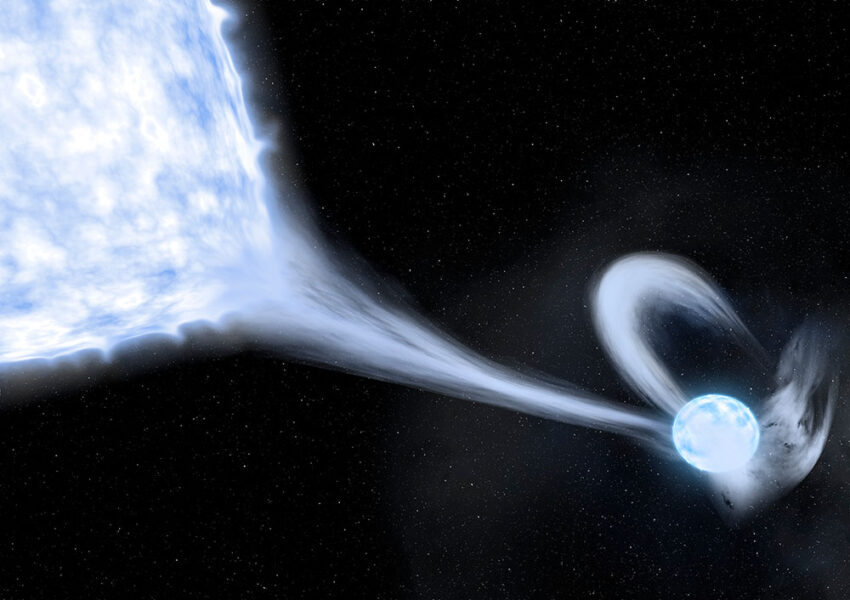Massive stars can produce twice as much carbon when they have a close binary companion, according to a new study. The result is a small but important step in understanding the cosmic origin of elements.

Ylva Götberg
“All of the rocky and metallic material we stand on, the iron in our blood, the calcium in our teeth, the carbon in our genes were produced billions of years ago in the interior of a red giant star,” wrote Carl Sagan in 1973. “We are made of star-stuff.”
Truth be told, scientists are still struggling to trace the origin of many elements, including carbon, the building block of life on Earth. We know that stars undoubtedly produce and eject carbon over the course of their lives. But stars come in many flavors, and it remains unclear how much carbon they each make.
Now scientists have turned the spotlight on a particular class of stars: binaries. A new study to be published in The Astrophysical Journal (preprint available here) shows that massive stars with companions could eject about twice as much carbon as isolated stars, making them especially prolific carbon factories.
Doing More Together
Massive stars make many heavy elements. In the hot stellar bellies, light elements fuse into heavier ones, giving rise to carbon, oxygen, and on up to iron. Fast streams of particles blowing off stars, called stellar winds, carry away a portion of these elements. And when a massive star explodes as a supernova, it ejects heavy elements far into space.

Wikipedia Commons / CC BY-SA 3.0
Scientists use theoretical models to study how stars evolve and to calculate how much of each element a star produces during its lifetime and how much it ejects into space. But most modeling has ignored the fact that massive stars like company. Most massive stars have companions, and that affects their evolution.
“Most of its life, a star is just burning hydrogen in its core; when that stops, the star expands and gets very big,” explains Rob Farmer (Max Planck Institute for Astrophysics), who led the new study. At this stage, an isolated star simply becomes a giant star.
However, the situation is different if the star has a close companion. In this case, the companion pulls the material off the expanding star, completely stripping away its outer layers. Such a stripped star develops a carbon-rich layer close to the surface, making it easier for its stellar winds, and to some extent also the ultimate explosion, to eject carbon.
Farmer estimates that stellar companions have stripped about a third of all massive stars — we can't ignore them!
When the researchers used a state-of-the-art simulation to track the evolution and carbon production of a stripped star, they confirmed that a massive star in a binary system ejects carbon more efficiently than an isolated star.
Chemical Evolution of the Universe
“Carbon is an abundant element, is important for life, we have many reasons to study it in detail,” says Donatella Romano (Astrophysics and Space Science Observatory, Italy). Romano, who wasn't involved in the study, estimates that massive stars produce most of the carbon in the universe.
However, she adds, other sources, such as red giant stars, also contribute to carbon production. Moreover, the carbon yield of any star depends on the environment in which it’s born, which calls for a more thorough analysis of many other possible evolutionary paths of massive and less massive stars.
“We are also interested in other heavy elements because we want to get a picture of the full chemical evolution of a galaxy,” Romano says.
Indeed, Farmer and colleagues are already investigating the production of other heavy elements. “That is much more computationally expensive to do," says Farmer. “That is why we looked at carbon first because it is simpler to understand and simpler to run.”
As stars deliver heavy elements into the interstellar medium throughout their lives, they set seeds for the next generation. That cycle has continued from the first stars to today, resulting in an ever-higher abundances of heavy elements in a galaxy. By combining the stellar and galactic theory, scientists hope to learn about this enrichment and how it has affected the evolution of galaxies, planetary systems, and ultimately, life.
 5
5









Comments
PGT
November 3, 2021 at 6:51 pm
The schematic has 8Be -- would that be a typo for 8 (Oxygen)?
Or is it some form of beryllium?
You must be logged in to post a comment.
Starbird
November 3, 2021 at 11:32 pm
It looks like it's the number of protons+neutrons not atomic number. It also has number 4 for helium and 12 for carbon.
You must be logged in to post a comment.
Curt-Nason
November 4, 2021 at 7:14 am
It is beryllium-8, which has a half-life of just 1 E-18 seconds. Inside a star it has a resonance energy level that allows it to absorb a helium nucleus and form carbon-12 before it decays back to two helium nuclei (alpha particles). Fred Hoyle figured that out. He knew it had to occur, otherwise there would be no carbon and no Fred Hoyle.
You must be logged in to post a comment.
jackkessler
November 5, 2021 at 8:14 pm
Our existence depends on a reaction that has to take place in a less than 10e-18 seconds window? Yikes! Sounds precarious.
You must be logged in to post a comment.
Anthony Barreiro
November 6, 2021 at 6:07 pm
But, as Fred Hoyle and Curt Nason have assured us, we know for sure that enough carbon was created in previous generations of stars to give Earth enough carbon to foster the evolution of life. What seems more precarious now is our human ability to refrain from burning more fossilized carbon and continuing to overheat the planet.
You must be logged in to post a comment.
You must be logged in to post a comment.